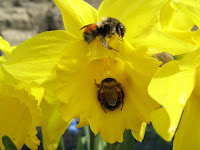 My good friend Helen in Powell River always offers me tea and "nummies" when I come over for a visit. In case you aren't familiar, a nummy is something delicious, yummy. Helen's nummies range from macaroons dipped in chocolate to sweet muffins. Ed's sure a lucky husband. He get nummies all the time.
My good friend Helen in Powell River always offers me tea and "nummies" when I come over for a visit. In case you aren't familiar, a nummy is something delicious, yummy. Helen's nummies range from macaroons dipped in chocolate to sweet muffins. Ed's sure a lucky husband. He get nummies all the time. At our cabin, I like to bake nummies of my own. Since our wood stove is going 24/7 during winter, I've created some unique ways to bake including a gutted toaster oven and a cast iron dutch oven. Here are a few of my nummy success stories. Follow the links for the recipes.
At our cabin, I like to bake nummies of my own. Since our wood stove is going 24/7 during winter, I've created some unique ways to bake including a gutted toaster oven and a cast iron dutch oven. Here are a few of my nummy success stories. Follow the links for the recipes. Toaster Oven Cabin Cake -- This cake doesn't have any eggs, perfect for minimal cabin ingredients. The toaster oven traps the radiant heat. Cooking time is slow, but this moist cake still comes out great.
Toaster Oven Cabin Cake -- This cake doesn't have any eggs, perfect for minimal cabin ingredients. The toaster oven traps the radiant heat. Cooking time is slow, but this moist cake still comes out great. Dutch Oven Rustic Apple Pie -- I put a metal rack inside my cast iron dutch oven and bake cakes and pies using the trapped heat. I used my wood stove thermometer and it gets to about 300 degrees inside. Some heated rocks on top of the pot to provide extra heat.
Dutch Oven Rustic Apple Pie -- I put a metal rack inside my cast iron dutch oven and bake cakes and pies using the trapped heat. I used my wood stove thermometer and it gets to about 300 degrees inside. Some heated rocks on top of the pot to provide extra heat. Dutch Oven Pineapple Upside-Down Cake
Dutch Oven Pineapple Upside-Down CakeHere is another stovetop dutch oven favourite. The cake is really rich, but nummies are NOT meant to be diet fare.
Thanks for looking at my "nummies" pictures. Stay for awhile, take a look at my index, there's lots more to see. Or come to www.PowellRiverBooks.com for more information about Wayne's Coastal BC Stories series of books. -- Margy




















